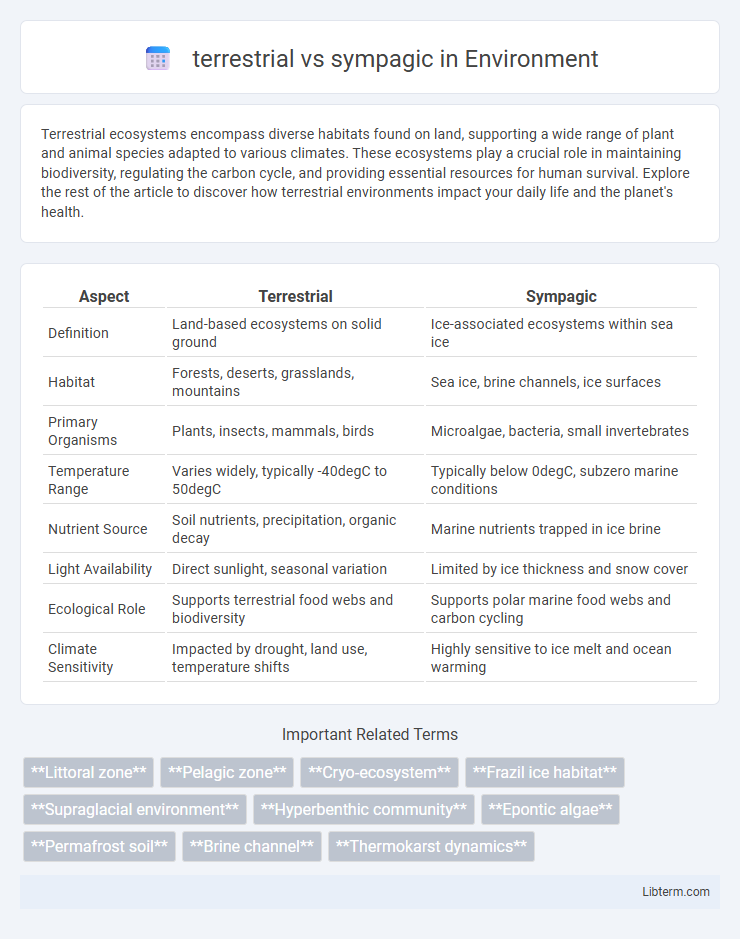Terrestrial ecosystems encompass diverse habitats found on land, supporting a wide range of plant and animal species adapted to various climates. These ecosystems play a crucial role in maintaining biodiversity, regulating the carbon cycle, and providing essential resources for human survival. Explore the rest of the article to discover how terrestrial environments impact your daily life and the planet's health.
Table of Comparison
| Aspect | Terrestrial | Sympagic |
|---|---|---|
| Definition | Land-based ecosystems on solid ground | Ice-associated ecosystems within sea ice |
| Habitat | Forests, deserts, grasslands, mountains | Sea ice, brine channels, ice surfaces |
| Primary Organisms | Plants, insects, mammals, birds | Microalgae, bacteria, small invertebrates |
| Temperature Range | Varies widely, typically -40degC to 50degC | Typically below 0degC, subzero marine conditions |
| Nutrient Source | Soil nutrients, precipitation, organic decay | Marine nutrients trapped in ice brine |
| Light Availability | Direct sunlight, seasonal variation | Limited by ice thickness and snow cover |
| Ecological Role | Supports terrestrial food webs and biodiversity | Supports polar marine food webs and carbon cycling |
| Climate Sensitivity | Impacted by drought, land use, temperature shifts | Highly sensitive to ice melt and ocean warming |
Introduction to Terrestrial and Sympagic Ecosystems
Terrestrial ecosystems consist of land-based environments such as forests, grasslands, and deserts, characterized by soil, vegetation, and atmospheric interactions. Sympagic ecosystems develop within sea ice, hosting unique microbial communities and specialized fauna adapted to extreme cold and seasonal ice dynamics. Understanding the distinct biotic and abiotic components of terrestrial and sympagic ecosystems is crucial for studying ecological processes and climate change impacts in polar and non-polar regions.
Defining Terrestrial Ecosystems
Terrestrial ecosystems are land-based environments characterized by diverse vegetation, soil types, and climate conditions supporting a wide range of flora and fauna. Unlike sympagic ecosystems, which are sea ice-associated and dominated by microbial life and specialized organisms, terrestrial ecosystems include forests, grasslands, deserts, and savannas, each with unique ecological processes. These ecosystems play a critical role in carbon cycling, biodiversity conservation, and providing habitat for terrestrial wildlife.
Understanding Sympagic Environments
Sympagic environments are unique ecosystems found within and beneath sea ice, characterized by complex interactions among ice, water, and organisms. Unlike terrestrial habitats, sympagic zones support specialized microbial communities, algae, and invertebrates adapted to extreme cold and seasonal light variations. Understanding sympagic environments is crucial for studying climate change impacts on polar biodiversity and biogeochemical cycles.
Key Differences Between Terrestrial and Sympagic Habitats
Terrestrial habitats are land-based ecosystems characterized by soil, vegetation, and diverse terrestrial fauna, while sympagic habitats refer to life associated with sea ice, involving organisms adapted to extreme cold and ice-covered environments. Key differences include the physical medium, with terrestrial habitats dominated by solid ground and sympagic habitats consisting of ice and adjacent seawater, influencing species' adaptations such as insulation in terrestrial animals versus antifreeze proteins in sympagic organisms. Biodiversity patterns also differ, as terrestrial ecosystems support a wider range of plants and animals compared to the specialized, often microbial and invertebrate communities thriving in sympagic zones.
Biodiversity in Terrestrial vs Sympagic Systems
Biodiversity in terrestrial systems is characterized by a wide range of plant and animal species adapted to stable land environments, supporting complex food webs and ecosystem functions. In contrast, sympagic biodiversity, found within sea ice ecosystems, includes unique microbial communities, algae, and ice-adapted invertebrates that contribute crucially to polar food chains and biogeochemical cycles. Differences in habitat conditions drive contrasting species diversity and ecological roles, with sympagic systems playing an essential role in global climate regulation and ocean productivity.
Adaptations of Flora and Fauna
Terrestrial flora and fauna exhibit adaptations such as deep root systems, thick bark, and drought-resistant leaves to thrive in soil and variable climates. Sympagic organisms, like ice algae and polar amphipods, develop antifreeze proteins, transparent bodies, and specialized metabolic pathways to survive in freezing, saline ice environments. These evolutionary traits enable species to optimize resource use and maintain functionality despite extreme temperature fluctuations and habitat constraints.
Environmental Challenges and Resilience
Terrestrial ecosystems face environmental challenges such as soil degradation, deforestation, and temperature fluctuations that impact biodiversity and ecosystem resilience. Sympagic environments, characterized by sea ice habitats, encounter threats like ice melt, salinity changes, and altered nutrient cycling, directly affecting microbial communities and ice-dependent species. Understanding adaptive mechanisms in both terrestrial and sympagic systems is crucial for predicting ecosystem stability and developing targeted conservation strategies under climate change stressors.
Human Impact on Terrestrial and Sympagic Ecosystems
Human activities have caused significant disturbances in terrestrial ecosystems through deforestation, urbanization, and agriculture, leading to habitat loss and biodiversity decline. In sympagic ecosystems, which include sea ice habitats, climate change and pollution disrupt species adapted to cold environments, threatening their survival and altering ecological dynamics. Both terrestrial and sympagic ecosystems face increased vulnerability due to human-induced climate warming, emphasizing the need for targeted conservation strategies.
Ecological Importance and Global Significance
Terrestrial ecosystems play a critical role in carbon sequestration, biodiversity support, and regulating climate through vegetation and soil interactions, while sympagic ecosystems, found within sea ice environments, are vital for nutrient cycling and serve as foundational habitats for Arctic and Antarctic food webs. The global significance of terrestrial habitats lies in their contribution to oxygen production and carbon storage, whereas sympagic communities influence global climate patterns by affecting albedo and ocean-atmosphere gas exchanges. Protecting both terrestrial and sympagic ecosystems is essential for maintaining planetary health and mitigating climate change impacts on a global scale.
Future Trends and Conservation Strategies
Future trends indicate increasing shifts in species distributions between terrestrial and sympagic habitats due to climate change-driven alterations in ice cover and temperature. Conservation strategies emphasize the integration of habitat connectivity, protection of critical breeding grounds, and adaptive management tailored to the unique ecological dynamics of both terrestrial and sea ice-associated ecosystems. Enhanced monitoring technologies and predictive modeling are crucial for anticipating habitat transitions and informing targeted preservation efforts.
terrestrial Infographic

 libterm.com
libterm.com